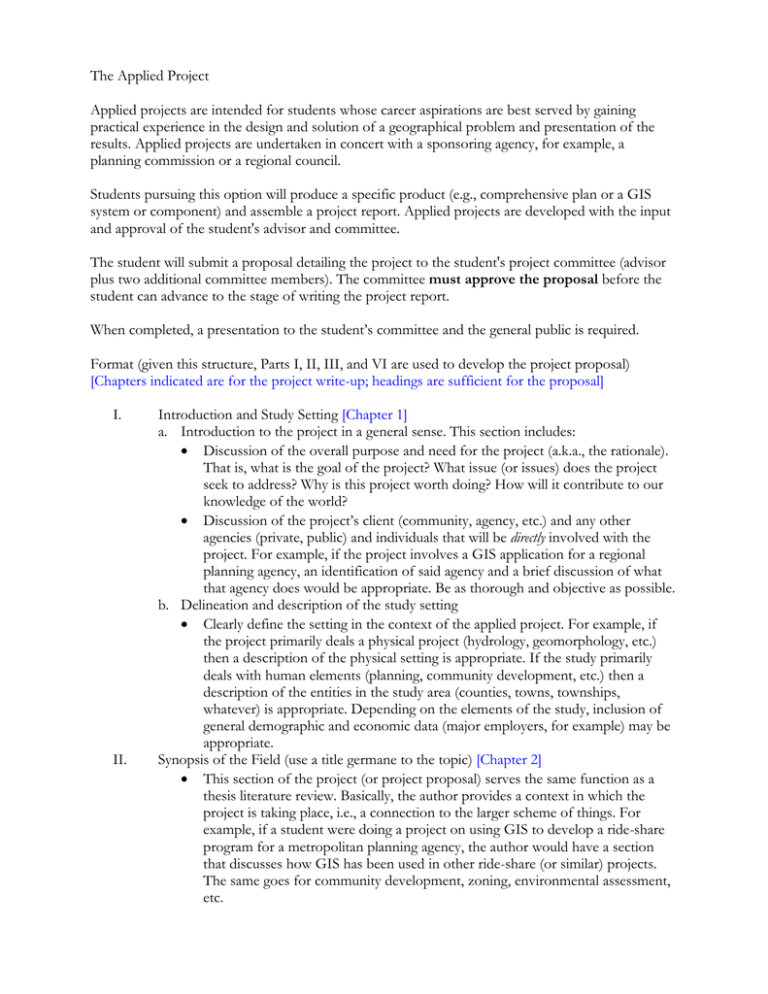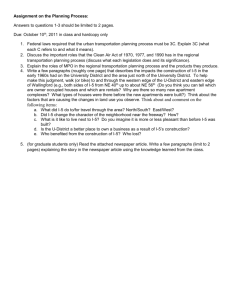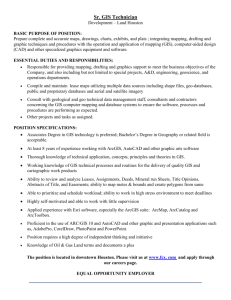The Applied Project
advertisement

The Applied Project Applied projects are intended for students whose career aspirations are best served by gaining practical experience in the design and solution of a geographical problem and presentation of the results. Applied projects are undertaken in concert with a sponsoring agency, for example, a planning commission or a regional council. Students pursuing this option will produce a specific product (e.g., comprehensive plan or a GIS system or component) and assemble a project report. Applied projects are developed with the input and approval of the student's advisor and committee. The student will submit a proposal detailing the project to the student's project committee (advisor plus two additional committee members). The committee must approve the proposal before the student can advance to the stage of writing the project report. When completed, a presentation to the student’s committee and the general public is required. Format (given this structure, Parts I, II, III, and VI are used to develop the project proposal) [Chapters indicated are for the project write-up; headings are sufficient for the proposal] I. II. Introduction and Study Setting [Chapter 1] a. Introduction to the project in a general sense. This section includes: • Discussion of the overall purpose and need for the project (a.k.a., the rationale). That is, what is the goal of the project? What issue (or issues) does the project seek to address? Why is this project worth doing? How will it contribute to our knowledge of the world? • Discussion of the project’s client (community, agency, etc.) and any other agencies (private, public) and individuals that will be directly involved with the project. For example, if the project involves a GIS application for a regional planning agency, an identification of said agency and a brief discussion of what that agency does would be appropriate. Be as thorough and objective as possible. b. Delineation and description of the study setting • Clearly define the setting in the context of the applied project. For example, if the project primarily deals a physical project (hydrology, geomorphology, etc.) then a description of the physical setting is appropriate. If the study primarily deals with human elements (planning, community development, etc.) then a description of the entities in the study area (counties, towns, townships, whatever) is appropriate. Depending on the elements of the study, inclusion of general demographic and economic data (major employers, for example) may be appropriate. Synopsis of the Field (use a title germane to the topic) [Chapter 2] • This section of the project (or project proposal) serves the same function as a thesis literature review. Basically, the author provides a context in which the project is taking place, i.e., a connection to the larger scheme of things. For example, if a student were doing a project on using GIS to develop a ride-share program for a metropolitan planning agency, the author would have a section that discusses how GIS has been used in other ride-share (or similar) projects. The same goes for community development, zoning, environmental assessment, etc. • III. IV. V. VI. VII. GIS project would include a section on GIS (as it related to the specific project), discussion of the GIS software and how it is capable of performing the proposed task, and (if applicable), discussion of hardware involved in the project. Students selecting the project option are involved in planning and/or community development projects would do the “planning equivalent.” • The bottom line is that the author should demonstrate an awareness of the framework within which the project is taking place. Project Structure/Deliverables [Chapter 3] • Akin to the Methodology section of a thesis, this section describes in detail the complete nature of the project. It addresses questions such as: − What will be done (what are the project deliverables)? − What information (data) is necessary to assemble the project deliverable(s)? How will you acquire this information? − How will the project deliverable(s) be accomplished? In other words, what tools or techniques will be used? Included here would be a description of hardware and software (for a GIS project, for example) or the comprehensive planning process (if the project involves development of such a plan). − What are the timelines/deadlines? − What agencies are involved directly and indirectly? For example, in addition to the client the project serves, does it involve coordination with several state agencies in order to be successful? If so, which ones? • In circumstances where students have an agreed-upon work plan for the internship, this section is built primarily out of what is agreed upon between the agency and the student. For example, all the Peace Corps and Community Development Fellows have a work plan that is developed shortly after they arrive in the field. It details the specific project(s) that the student will be involved in during the course of the fieldwork. Project Implementation [Chapter 4] • Akin to the Results section of a thesis, here the student discusses what actually happened during the course of the project. • Description of the compilation of the project deliverable(s) including: − Information utilized (data, surveys, etc.) − Detailed discussion of the steps in the process (like hearings, committee review, adoption procedures, etc.) − Detailed discussion of the output Conclusions and Recommendations [Chapter 5] • Includes a critical analysis of the project (successes, failures, etc.) and recommendations for similar future projects. • Also includes, in some way, the answer to the question so what? How did the project relate to the knowledge about planning, GIS, etc. Bibliography [Begin on a new page as you would a chapter, but don’t use the word “Chapter”] Appendices [Appendix A, B, C, etc.] • Copies of the project deliverables (reports, maps, ordinances, etc.) The write-up is preceded by the appropriate preliminary material (title page, approval page, acknowledgments, table of contents).





